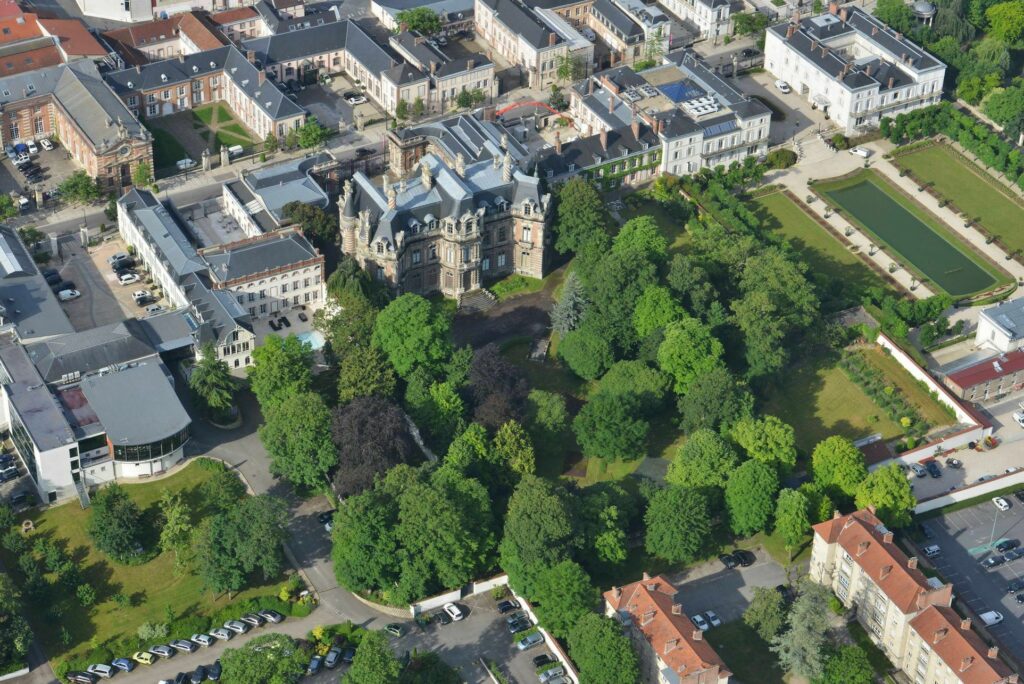CELEBRATING CHAMPAGNE
France’s Champagne region, famous for its “bubbly”, is entering a new era when it comes to food and wine tourism, as Château Perrier is set to open as the “Champagne Museum of Wine and Regional Archaeology”
Since 2011, the City of Epernay has been involved in a major rehabilitation project for Château Perrier to house the museum. A major in-depth work is under way to introduce as many people as possible to a site and collections of international renown. It was during the summer of 2017 that the museum’s construction work was officially launched, with demolition work (walls, ceilings and parquet floors with no historical interest) and cleaning. The work of major works, electricity, air conditioning and heating then began on the historic monument.
With 96 rooms covering 4,200 sq m, Château Perrier forms part of the Champagne Hillsides, Houses and Cellars included on the UNESCO World Heritage List.
It all began in 1811, when cork-manufacturer Pierre-Nicolas Perrier married Adèle Jouët and founded what was to become the celebrated House of Perrier-Jouët. In 1854, they commissioned the building of a Louis 13th style chateau.
The chateau was built by Epernay architect Pierre-Eugène Cordier but designed by the couple themselves in the Louis Treize style so dear to their hearts. It originally served as the Perrier private family home and stands today as a magnificent example of Late Romantic Era French architecture.

In World War II the chateau served as Army Headquarters, first for the British Army (1940), then for the Germans (1942-1944) then for the Americans in 1945. Following that, it was then converted into the Epernay Municipal Library and Museum, making an important contribution to the magnificent built heritage of the “Champagne Avenue”.
Since 1950 the chateau has housed the regional museum of prehistory and archaeology, based on a major donation of artworks and archaeological artefacts to the town of Epernay in 1893.
Over the past three years, the restoration work has been intense. It began on the roof, repairing skylights and plugging leaks. The facades have been stripped and cleaned. Bricks and stones have been changed. Traces of shrapnel, particularly at the south façade of the castle, have been preserved as witnesses to history. Roof openings have been created as part of the installation of heating and air conditioning.
Inside Château Perrier, the four levels have been affected by work. The museum staircase has also regained all its splendour, and now houses a majestic chandelier. Outside, the courtyard in front of the château has been repaved.
Finally, the garden has been redeveloped. Pedestrian pathways have been created, new trees planted, candelabras and light hydrants installed and a pond has been created.
Franck Leroy, Mayor of Epernay, says the project was undertaken to underline the fact that Epernay is a “city of heritage”: “Despite several destructions and fires since its birth in the 5th century, Epernay has managed to preserve architectural and cultural remains that today contribute to its reputation. The City pays great attention to their renovation and promotion. Continuing to develop these riches is the assurance of strengthening the influence of our territory and attracting more visitors. And the inclusion of the Champagne Hillsides, Houses and Cellars on the UNESCO World Heritage List makes us even more ambitious.”

More than 100,000 archaeological and wine-producing pieces are presented in the museum. In terms of archaeology, the museum’s collection currently consists of 80,000 regional pieces. It is the number one collection of regional archaeology in France, after the National Archaeology Museum of Saint-Germain-en-Laye.
Visitors will be able to enjoy not only the café, located in the courtyard of the château, but also the redeveloped park. A reception area, a bookshop, an educational area for groups and schoolchildren, as well as a documentation centre will also be integrated.
UNESCO: Champagne Hillsides, Houses and Cellars
In 2015, 14 cellars, hillsides and sites were registered by UNESCO in the category “cultural landscape”. Visitors are able to take in elements of this heritage in the gentle hills of Hautvillers, Haÿ, Mareuil, Saint-Nicaise, or the cellars of prestigious Champagne brands such as Pommery, Veuve-Clicquot, Ruinart, Taittinger. Of course, one shouldn’t forget to check out the Institute Fort Chabrol for wine and oenological research.
The landscape encompasses sites where the method of producing sparkling wines was developed on the principle of secondary fermentation in the bottle from the early 17th century to its early industrialisation in the 19th century. There are three distinct ensembles: the historic vineyards of Hautvillers, Aÿ and Mareuil-sur-Aÿ, Saint-Nicaise Hill in Reims, and the Avenue de Champagne and Fort Chabrol in Epernay. These three components – the supply basin formed by the historic hillsides, the production sites (with their underground cellars) and the sales and distribution centres (the Champagne Houses) – illustrate the entire champagne production process. The property bears clear testimony to the development of a very specialized artisan activity that has become an agro-industrial enterprise.
The Champagne Houses
Around 100 houses vinify their own selection of grapes and vintages here, adhering to a demanding traditional process. Some 20 of them organise visits to their cellars: Ayala in Aÿ, Mercier in Epernay, Duchêne Canard in the château of Ludes, Taittinger in the crypts of the former Abbey St Nicaise, Ruinart in the chalk quarries of Reims. It’s enough to make you drunk before even sipping the bubbly!
WWI sites
Due to its geographical location, the Champagne-Ardenne region was the scene of many battles during the First World War. Thirty sites, cemeteries and monuments of the region welcome visitors to come visit these moments of history.
Visitors can have their names indelibly etched into the museum’s history
The Champagne Museum of Wine and Regional Archaeology needs the support of private donors to carry out its projects with ambition. The City of Epernay, with the support of the Heritage Foundation, has launched an appeal for donations. Individuals and businesses alike can participate.
The Champagne Museum of Wine and Regional Archaeology is scheduled to open in Q1 2021.
